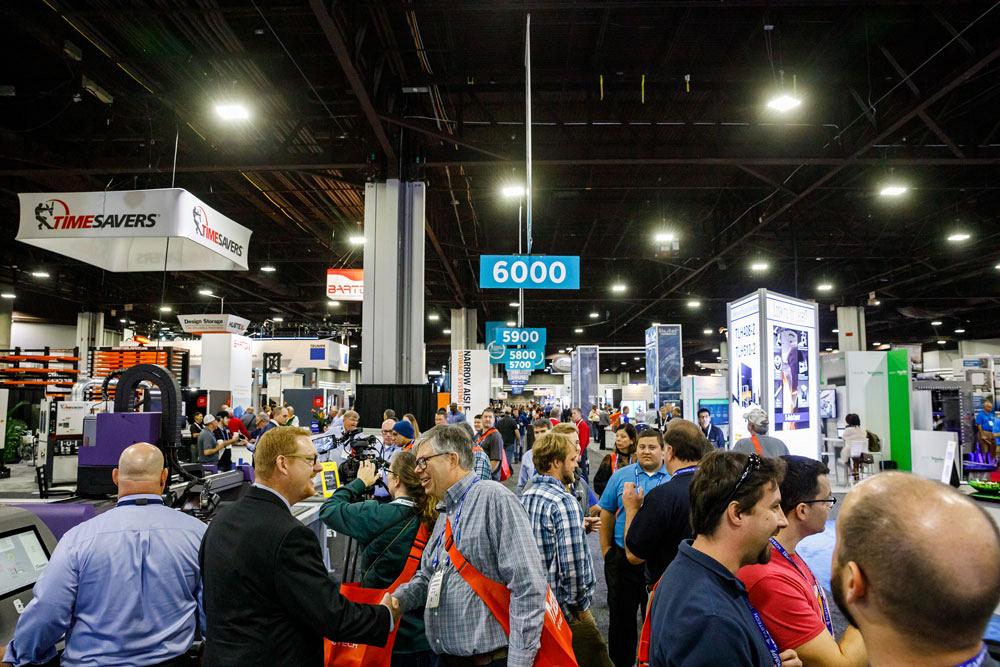Senior Editor
- FMA
- The Fabricator
- FABTECH
- Canadian Metalworking
Categories
- Additive Manufacturing
- Aluminum Welding
- Arc Welding
- Assembly and Joining
- Automation and Robotics
- Bending and Forming
- Consumables
- Cutting and Weld Prep
- Electric Vehicles
- En Español
- Finishing
- Hydroforming
- Laser Cutting
- Laser Welding
- Machining
- Manufacturing Software
- Materials Handling
- Metals/Materials
- Oxyfuel Cutting
- Plasma Cutting
- Power Tools
- Punching and Other Holemaking
- Roll Forming
- Safety
- Sawing
- Shearing
- Shop Management
- Testing and Measuring
- Tube and Pipe Fabrication
- Tube and Pipe Production
- Waterjet Cutting
Industry Directory
Webcasts
Podcasts
FAB 40
Advertise
Subscribe
Account Login
Search
FABTECH 2018: Metal fabrication for the next generation
Show shines a light on today’s youngest workers, Gen Z
- By Tim Heston
- December 5, 2018
- Article
- Shop Management
David Stillman felt confident his son Jonah would make the meeting on time. He forwarded him the client name and address. Jonah was new to the family business—he was only 19, after all—but he knew that he at least had the wherewithal to show up to an important meeting on time.
David arrived at the client’s office, asked to see if his son made it, and the receptionist nodded. “She told me she had met my son, told me how nice he was and how much I must enjoy working with him. Right then I knew he was going to give me a hard time for beating me to the meeting. We walked out to the conference room and I didn’t see him. I asked, ‘Where’s Jonah?’ They told me, ‘Oh, he’s joining via Skype!’”
The Stillmans, who run a consulting business called Gen Z Guru, told this story to an audience on the final day of FABTECH®, and asked the show’s attendees a poignant question: Did Jonah do what he promised? Did he make the meeting, or was he just “phoning it in”? Some agreed with the latter; a videoconference just isn’t the same as a face-to-face meeting. Other (mostly younger) attendees agreed with the former; he did indeed make the meeting. He was simply being pragmatic, using technology to be more efficient.
This story drives home an overarching theme of this year’s FABTECH show, which was held Nov. 6-9. The show welcomed more than 1,500 exhibiting companies and a total of 33,755 attendees from 75 countries to the Georgia World Congress Center in Atlanta.
In the past shop managers had a starkly different view of technology, particularly when it comes to “big data” and other buzzwords. Welders of older generations might think that when a company installs an arc-on-time monitor, it is a classic case of micromanagement. The youngest of welders—those who never knew a time without smartphone apps—would be surprised if their welding machines weren’t connected, and if their welding arc’s on-time and characteristics weren’t tracked and analyzed.
The youngest workers today grew up in a world connected by technology—a world with Google Voice, Alexa, and Siri—and they’d be surprised if that connectivity stopped as they stepped onto the shop floor. They expect machines to be communicating, feeding each other data, sometimes even learning and working autonomously. Considering the technology on display at FABTECH, the age of the connected fab shop floor has only just begun.
A Connected Life
The Stillmans’ consulting business focuses on generations: the boomers, Generation X, millennials, and now Generation Z, born between 1995 and 2012, the oldest of whom are just now entering the workforce. Those in Generation Z haven’t known a time without technology, and they don’t remember a time before Google. They value face time, but why not use technology to make that face time more efficient and effective?
The oldest millennials came of age during the roaring 1990s followed by the tragedy of 9/11. The oldest of Generation Z came of age during the Great Recession. They take technology as a given, but they’re also highly pragmatic and competitive. While millennials want meaning, Generation Zers take a more practical approach. They saw their parents suffer from college debt and job loss, and they don’t want to suffer the same fate. As the Stillmans explained, Generation Z is pragmatic about technology too. They use technology as a tool and don’t use tech for its own sake.
Those from Generation Z probably would have appreciated Eric Fogg’s presentation, part of FABTECH’s extensive conference. He’s the co-founder of MachineMetrics, a predictive analysis platform that focuses on machining and metal fabrication. At a bare minimum, the platform tracks actual uptime of machines—not the clock-in and clock-out times tracked by operators, but the actual value-added time during which a machine is cutting, bending, welding, and otherwise making parts.
“I worked in machine shops and prototypes for a number of years, and I realized there was a ton of information that was completely unavailable,” Fogg said. “Oftentimes I recall getting to Friday afternoon and only then finding out that we didn’t ship enough parts to the customer.”

Dan Kara, vice president, robotics, WTWH Media, gives a broad overview of the state of robotics in metal fabrication as part of the show’s FABx Tech Talks, modeled on the popular TED Talks.
He then showed a slide that surprised his audience. Ask most shop managers about the uptime on a certain machine, and they might throw out a number between 70 and 85 percent. Sometimes it’s a guess, sometimes it’s based off clock-in data from shop management software. “We surveyed over 300 shops, and want to know the average machine uptime? It’s only 31.7 percent.” This is the value-added time, when parts are being made. “Everyone knows about the big stoppages, but people overlook the brief stoppages. But all those 5- and 10-minute downtimes add up.”
Fogg recalled revealing a low machine uptime to one metal fabrication shop manager. His supervisors were upset, but the top manager just smiled. “He said, ‘You guys don’t get it. We make money now. This is a viable business now. I would have been upset had that number been, say, 98 percent. But when I see this [low utilization] number, I see a huge amount of potential to grow the business.’”
Can’t Find a Tool or Gauge? Print It
Why would a machine be down unexpectedly? Maybe the job calls for tooling that the operator “makes work” on the press brake, or perhaps an oddball part that’s difficult to gauge is to blame.
Like past years, this year’s FABTECH again featured an Additive Pavilion, but this year more exhibitors showed not just parts printed out of metal, but tooling printed out of plastic and composites. Cincinnati Incorporated, which is selling small 3-D printers, showed printed press brake tools and backgauges. Wilson Tool highlighted its 3-D printing services, including printed tools and backgauges. And Markforged showcased a special offset tool printed out of composite material.
Will additive manufacturing transform metal fabrication? Probably not. It’s hard to imagine an additively produced part being more cost-effective than a stamped or laser-cut component. But when it comes to custom tools, fixtures, and even robotic end effectors, exhibitors at FABTECH showcased additive’s enormous potential.
Rise of the Robots
Gen Z also can’t remember a time without robots. While their parents and grandparents remember manufacturing that downsized dramatically thanks to globalization and automation, Gen Z is growing up in a manufacturing industry where automation is a fact of life. They take it for granted that a press brake control gives them a graphical simulation of a bending sequence, or that a robot’s welding path sequence can be simulated offline.
In the years to come, many Gen Zers may well be working in a shop that looks utterly different from the fabrication shops of today. One presentation made by automation integrator Acieta, at the show’s Smart Manufacturing Hub theater, showed an image of a fully automated fab shop integrated recently at an OEM. Blanks emerge from a laser and are picked by a robot, which places pieces on a conveyor that transports them to a robotic bending cell. After robotic bending comes an advanced fixtureless welding cell in which a material handling robot handles a piece as another robot welds. The entire setup eliminated the need for dozens of fixtures.
“The company saw a huge reduction in lost parts,” said Pete Rogers, Acieta’s vice president of operations. “Previously the company laser-cut a batch of parts, stacked the sheets up on pallets, moved them to the other end of the facility for bending, then stacked them on pallets to transport them to welding. The automated cell now allows for them to run one single part at a time, without the need for a minimum batch size. And no one touches the part as it moves from laser cutting through bending and welding.”
Entering the metal fabrication workforce now, Gen Zers have arrived at the robotics party just in time. “It’s been a good year for robotics, and industrial robotics in particular,” said Dan Kara, vice president, robotics, WTWH Media, speaking at FABTECH’s FABx Tech Talks, modeled after the popular TED Talks. “Recently the International Federation of Robotics released its annual survey, and in 2017 the industry sold 381,000 industrial robots, which is 30 percent more than was sold in 2015.”
Most interesting is the fact that 10 percent of that number was purchased by the metal manufacturing sector. In fact, purchases in this sector jumped 55 percent.

FABTECH speakers David Stillman, a Generation Xer, and his son Jonah, of Generation Z, run a consulting firm called Gen Z Guru, which focuses on the economy’s youngest workers.
That growth could certainly be seen on the show floor, where more types of robots are entering the fray, including collaborative robots. At this year’s show, for instance, Universal Robots and Arc Specialties introduced a cobot that can not only weld, but also (grasping a manual torch) plasma-cut.
The kinds of collaborative robots are expanding, too, to include not only the familiar arms, but also exoskeletons. “These kinds of products initially were developed for the rehab and quality of life markets, and today these companies are looking for a new, much larger market,” Kara said. “They’re looking to manufacturing.”
As just one example, Levitate Technologies exhibited an exoskeleton technology that could help workers lift and manage heavy objects, like guiding heavy plate through a bending cycle on a press brake.
Record-breaking Business
“Business has never been better.” So said attendee Greg Williams, president of Southern Metalcraft in Lithonia, Ga. The company hopes to move to a new, larger building next year. “We beat last year’s sales by the beginning of October,” he said, “and we’re expecting similar growth next year.”
Numerous other attendees said something similar. Despite headwinds when it comes to material prices, demand remains solid. The economy has a strong footing.
Regardless, the trade war and metal prices are obvious headwinds, as Chris Kuehl, economic analyst for the Fabricators & Manufacturers Association, pointed out during the FMA economic forecast breakfast during the show. Tariffs on imported metal were 25 percent, and yet the average increase in prices between this year and last has been more than 40 percent. What justifies the difference? Demand from a hot economy.
“The steel companies are making money while the sun is shining,” Kuehl said, adding that uncertainty about the future—how long tariffs will be in place, who will receive exclusions, and so on—has complicated capacity planning.
As Kuehl explained, most expect the economy to grow nicely into 2019. But with the Fed having its eye on inflation, interest rates are steadily rising. “We’re finally seeing real inflation, though it’s well under control,” Kuehl said. “Up until now we’ve been more or less immune to wage inflation. There was a law that used to work called the Laffer Curve. It was even logical; as the employment rate goes down, companies have to work harder to keep talent, and so wages go up. And that didn’t happen this time until very recently.”
Automation Makes It Possible
During their talk, on the final morning of FABTECH, the Stillmans of Gen Z Guru pointed out that although a fabricator’s youngest workers may be digital natives and think that meeting via videoconference isn’t at all different than meeting face to face, they aren’t entitled or self-centered as they’re often caricatured to be.
They have great respect for, and work well with, their elders, including the boomer generation. In fact, they probably would work well with show attendee Ken Kipe, a newly appointed fabrication supervisor charged to build a stainless fabrication operation to serve the equipment needs of Martin’s Famous Pastry Shoppe in Chambersburg, Pa.
“Years ago I started my own manufacturing company and revolutionized the dairy industry in this country,” he said. “We introduced the parallel milking system. The industry laughed at us and told us there was no way you could milk a cow between its back legs. Now 80 percent of the cows are milked that way. I had that company for 20 years and sold it.”
Hearing that anecdote, a Gen Zer probably would be transfixed.
Kipe came out of retirement to launch a new fab shop, and his visit to FABTECH was his first in more than 15 years. What’s changed and what’s stayed the same?
He responded by saying that, although everything is faster (especially laser cutting), the industry’s technological fundamentals haven’t changed. “Cutting and bending and welding, the core of it all hasn’t changed. But being able to computer-control the equipment makes it much more user-friendly. In the past you had people work for years as an apprentice to learn the trade. They really learned how to run a piece of equipment. Now you rely on the computer to do that. That’s why today I hire for attitude. I can teach anyone to do the things that need to be done, and it’s so neat to see the automation come into this industry that makes it all possible.”
FABTECH returns to Chicago Nov. 11-14, 2019. For more information, visit www.fabtechexpo.com.
About the Author

Tim Heston
2135 Point Blvd
Elgin, IL 60123
815-381-1314
Tim Heston, The Fabricator's senior editor, has covered the metal fabrication industry since 1998, starting his career at the American Welding Society's Welding Journal. Since then he has covered the full range of metal fabrication processes, from stamping, bending, and cutting to grinding and polishing. He joined The Fabricator's staff in October 2007.
Related Companies
subscribe now

The Fabricator is North America's leading magazine for the metal forming and fabricating industry. The magazine delivers the news, technical articles, and case histories that enable fabricators to do their jobs more efficiently. The Fabricator has served the industry since 1970.
start your free subscription- Stay connected from anywhere

Easily access valuable industry resources now with full access to the digital edition of The Fabricator.

Easily access valuable industry resources now with full access to the digital edition of The Welder.

Easily access valuable industry resources now with full access to the digital edition of The Tube and Pipe Journal.
- Podcasting
- Podcast:
- The Fabricator Podcast
- Published:
- 04/16/2024
- Running Time:
- 63:29
In this episode of The Fabricator Podcast, Caleb Chamberlain, co-founder and CEO of OSH Cut, discusses his company’s...
- Trending Articles
Tips for creating sheet metal tubes with perforations

Supporting the metal fabricating industry through FMA

JM Steel triples capacity for solar energy projects at Pennsylvania facility

Fabricating favorite childhood memories

Omco Solar opens second Alabama manufacturing facility

- Industry Events
16th Annual Safety Conference
- April 30 - May 1, 2024
- Elgin,
Pipe and Tube Conference
- May 21 - 22, 2024
- Omaha, NE
World-Class Roll Forming Workshop
- June 5 - 6, 2024
- Louisville, KY
Advanced Laser Application Workshop
- June 25 - 27, 2024
- Novi, MI



























